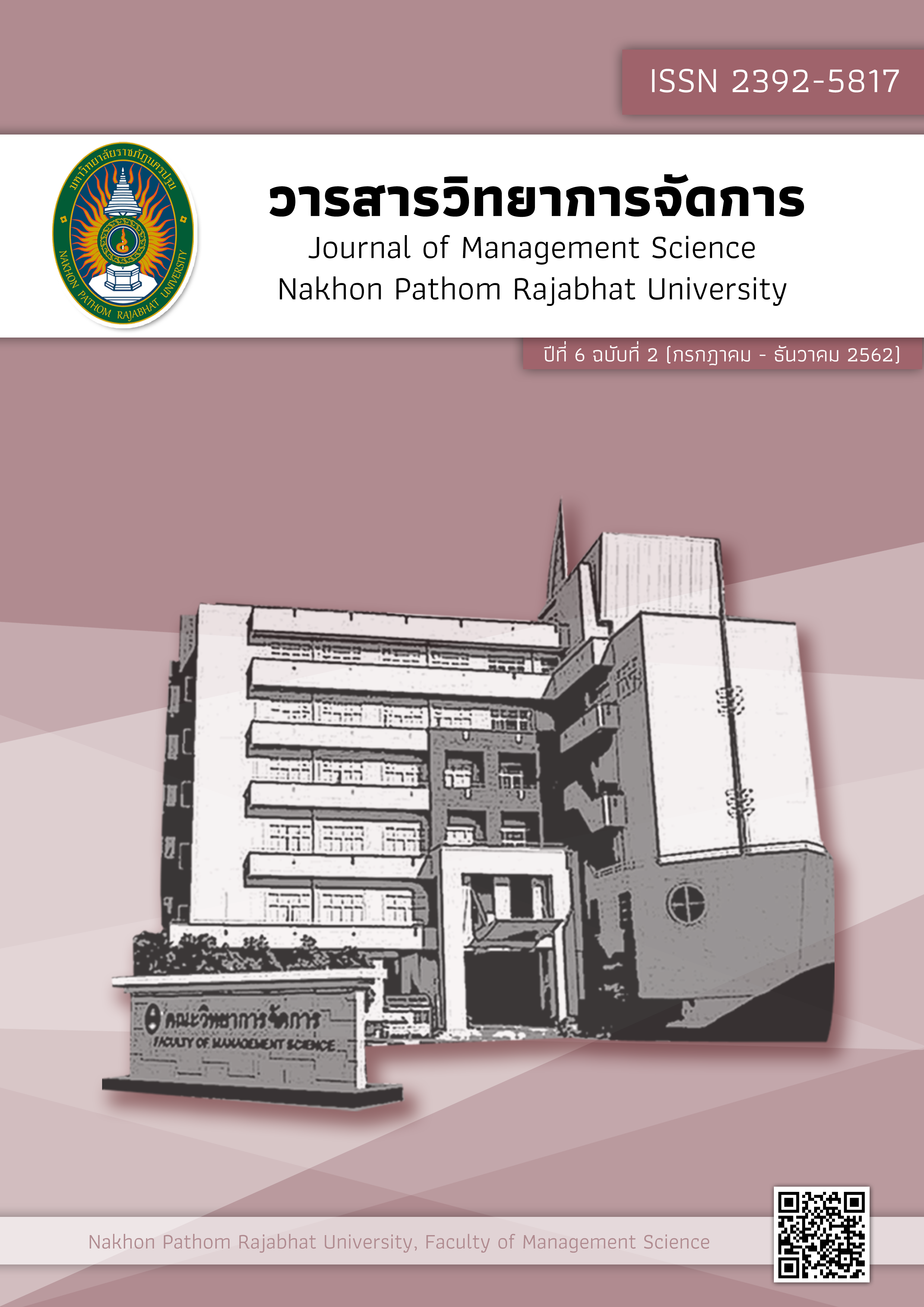แนวทางพัฒนาส่วนประสมการตลาด การท่องเที่ยวเชิงวัฒนธรรมในจังหวัดราชบุรี
Main Article Content
บทคัดย่อ
การวิจัยครั้งนี้ มีวัตถุประสงค์เพื่อ 1. ศึกษาถึงพฤติกรรมการท่องเที่ยวเชิงวัฒนธรรม ในจังหวัดราชบุรีของนักท่องเที่ยวจำแนกตามคุณลักษณะส่วนบุคคล 2. ศึกษาปัจจัยส่วนประสมทางการตลาด ที่มีผลต่อการท่องเที่ยวเชิงวัฒนธรรม ในจังหวัดราชบุรี และ3. ศึกษาแนวทางพัฒนาส่วนประสมการตลาด การท่องเที่ยวเชิงวัฒนธรรม ในจังหวัดราชบุรี รูปแบบการวิจัยครั้งนี้ใช้ระเบียบวิธีวิจัยแบบผสมผสาน ประกอบด้วยการวิจัยเชิงปริมาณและเชิงคุณภาพ ในส่วนการวิจัยเชิงปริมาณกำหนดกลุ่มตัวอย่างที่ใช้ในการวิจัยได้แก่ นักท่องเที่ยวตามแหล่งท่องเที่ยว เชิงวัฒนธรรม จังหวัดราชบุรี จำนวน 400 ราย ใช้วีการเลือกตัวอย่างแบบสะดวก เครื่องมือที่ใช้ในการเก็บข้อมูลได้แก่ แบบสอบถามที่สร้างขึ้นโดยผู้วิจัย โดยค่าความตรงด้านเนื้อหาระหว่าง 0.67 – 1.00 ทดสอบค่าความเชื่อมั่นด้วยสัมประสิทธิ์แอลฟา ของครอนบาช พบค่าความเชื่อมั่นด้านส่วนประสมทางการตลาดมีค่าความเชื่อมั่นในช่วง 0.72-0.86 ส่วนพฤติกรรมการท่องเที่ยวมีค่าความเชื่อมั่นเท่ากับ 0.88 สถิติที่ใช้ในการวิเคราะห์ข้อมูล ได้แก่ ค่าร้อยละ ค่าเฉลี่ย ส่วนเบี่ยงเบนมาตรฐาน การทดสอบค่าที การวิเคราะห์ความแปรปรวนทางเดียว และการวิเคราะห์ถดถอยเชิงพหุ สำหรับการวิจัยเชิงคุณภาพ ผู้ให้ข้อมูลหลัก ผู้วิจัยใช้การเลือกตัวอย่างแบบเฉพาะเจาะจงจาก ผู้ที่มีประสบการณ์เกี่ยวกับการจัดการท่องเที่ยวเชิงวัฒนธรรม และผู้มีส่วนเกี่ยวข้อง ที่ยินดีให้ความร่วมมือในการตอบข้อคำถาม จำนวน 3 ราย
ผลการวิจัยพบว่า
1. พฤติกรรมการท่องเที่ยวเชิงวัฒนธรรมจังหวัดราชบุรีจะมีความแตกต่างกันในด้านการศึกษา และประสบการณ์การท่องเที่ยว อย่างมีนัยสำคัญทางสถิติที่ระดับ 0.01
2. ปัจจัยส่วนประสมทางการตลาด ที่มีผลต่อการท่องเที่ยวเชิงวัฒนธรรม จังหวัดราชบุรี ในภาพรวม โดยมีอำนาจการพยากรณ์เท่ากับร้อยละ 55 ซึ่งปัจจัยส่วนประสมทางการตลาดที่มีผลต่อการท่องเที่ยวเชิงวัฒนธรรม จังหวัดราชบุรี ในภาพรวมได้แก่ ลักษณะทางกายภาพ (b=0.40) ราคา (b=0.26) บุคลากร (b=0.24) และ ผลิตภัณฑ์ (b=0.21) ตามลำดับโดยสามารถเขียนสมการพยากรณ์ได้ดังนี้
Y = 1.72+ 0.21X1 *+ 0.26 X2 **+ 0.10 X3 + 0.11 X4 + 0.24 X5 **+ 0.04 X6 + 0.40 X7**
3. แนวทางพัฒนาส่วนประสมการตลาด การท่องเที่ยวเชิงวัฒนธรรม จังหวัดราชบุรี ต้องอาศัยความเข้าใจของ ปัจจัยที่ดึง และปัจจัยที่ใช้ดัน ให้นักท่องเที่ยวมีความประทับใจ กลับมาเที่ยวซ้ำ รวมถึงบอกต่อในความประทับใจของสถานที่เที่ยวให้คนที่รู้จัก เป็นการพัฒนาส่วนประสมการตลาดไปสู่ความยั่งยืน โดยผู้มีส่วนได้เสียต้องให้ความสำคัญในเรื่องการเปลี่ยนแปลงของเทคโนโลยี การสร้างอัตลักษณ์ของชุมชน และการพัฒนารูปแบบของการจัดการความรู้ในท้องถิ่นควบคู่ไปด้วย
* วิทยานิพนธ์หลักสูตรบริหารธุรกิจมหาบัณฑิต สาขาการจัดการทั่วไป คณะวิทยาการจัดการ มหาวิทยาลัยราชภัฏนครปฐม
ภายใต้การควบคุมของอาจารย์ รองศาสตราจารย์ ดร. สุวัฒน์ ฉิมะสังคนันท์ และอาจารย์ ดร. วิศิษฐ์ ฤทธิบุญไชย
Corresponding author : Kanokwan.99sinsawang@gmail.com
Article Details
ทัศนะและข้อคิดเห็นของบทความที่ปรากฏในวารสารฉบับนี้เป็นของผู้เขียนแต่ละท่าน ไม่ถือว่าเป็นทัศนะและความรับผิดชอบของกองบรรณาธิการ
เอกสารอ้างอิง
กรมประชาสัมพันธ์. (2560) . การท่องเที่ยวจังหวัดราชบุรี. [ออนไลน์]. ค้นเมื่อ 20 กุมภาพันธ์ 2560 จาก https://nwnt.prd.go.th/centerweb/News/NewsDetail?NT01_NewsID=TNECO6002060010028.
ชูชัย สมิทธิไกร. (2553). พฤติกรรมผู้บริโภค. กรุงเทพฯ: สำนักพิมพ์แห่งจุฬาลงกรณ์มหาวิทยาลัย.
ฐานเศรษฐกิจ. (2559).ท่องเที่ยวไทยปี 58 ทำสถิติใหม่ โกยรายได้ทะลุเป้า2.23ล้านล้าน. [ออนไลน์]. ค้นเมื่อ 20 กุมภาพันธ์ 2560 จากhttps://www.thansettakij.com/content/25115.
บุญเลิศ จิตตั้งวัฒนา. (2548). อุตสาหกรรมการท่องเที่ยว. กรุงเทพฯ : เพรส แอนด์ ดีไซน์.
บุปผา พิกุลแก้ว และคณะ. (2550). รายงานวิจัยฉบับสมบูรณ์โครงการแนวทางการมีส่วนร่วมของภาคธุรกิจในการพัฒนากิจกรรมการท่องเที่ยวทางธรรมชาติอย่างยั่งยืนบนพื้นที่เกาะช้าง กิ่งอำเภอเกาะช้าง จังหวัดตราด. กรุงเทพฯ : สำนักงานกองทุนสนับสนุนการวิจัย (สกว.).
เพ็ชราภรณ์ ชัชวาลชาญชนกิจ และพรรณรัตน์ อาภรณ์พิศาล. (2561). อิทธิพลส่วนประสมการตลาดที่มีต่อประสิทธิผลการท่องเที่ยวเชิงวัฒนธรรม ตลาดน้ำลำพญา.วารสารปาริชาต มหาวิทยาลัยทักษิณ. 31 (3).155-160.
มนรัตน์ ใจเอื้อ. (2559). รูปแบบการตลาดเพื่อพัฒนาการท่องเที่ยวเชิงมรดกวัฒนธรรม: ชุมชนบางหลวงตำบลบางหลวง อำเภอบางเลน จังหวัดนครปฐม.วารสารวิชาการ ศรีปทุม ชลบุรี.12(3).12-24.
รัฐนันท์ พงศ์วิริทธิ์ธร เบญญาภา กันทะวงศ์วาร รุจิรา สุขมณี และชัชวิน วรปรีชา.(2556).แนวทางการพัฒนาส่วนประสมทางการตลาดโครงการหลวงหนองหอย เพื่อการท่องเที่ยวเชิงเกษตรอย่างยั่งยืน โดยประยุกต์ใช้การวิเคราะห์คาโนโมเดล.วารสารเทคโนโลยีสุรนารี. 7 (1).147-35.
วรรณา วงษ์วานิช (2546) .ภูมิศาสตร์การท่องเที่ยว.(พิมพ์ครั้งที่ 2) กรุงเทพฯ : ภาควิชาภูมิศาสตร์ คณะสังคมศาสตร์ มหาวิทยาลัยศรีนครินทรวิโรฒประสานมิตร.
ศิริวรรณ เสรีรัตน์ และคณะ. (2546). การบริหารการตลาดยุคใหม่ (ปรับปรุงใหม่ล่าสุด). กรุงเทพฯ: ธรรมสาร.
สุดาพร กุณฑลบุตร. (2550). หลักการตลาดสมัยใหม่. กรุงเทพฯ: จุฬาลงกรณ์มหาวิทยาลัย.
Cochran, W.G. (1953).Sampling Techniques. Experimental Designs, New York. Cuyno,
Howell, David W. (1993). Passport : an introduction to the travel and Tourism industry. (2nd ed.) N.P. South Western Publishing,
Kotler, P. (2000). Marketing Management (10 ed.). New Jersey: Prentice-Hall, Inc.,
Kotler, P. ; Bowen, J. and Makens, J.. (1996). Marketing for Hospitality and Tourism. New Jersey : Prentic-Hall Inc.,
McCarthy Jerome E. & Perreault, William D. (1991). Essentials of Marketing (5 ed.). United States: E. Jerome McCarthy and Associates. New York: McGraw-Hill, Inc.
Richards, G. (1995).ATLAS cultural tourism research. Retrieved February 16, 2017 from https://www.tram-research.com/cultural_tourism_in_europe.PDF.
Ryan, Chris. (1993). Recreational Tourim : A Social Science Perspective. Routledge : London and New York.
Schiffman, Leon G. & Leslie Lazar Kanuk. (2000). Consumer behavior. (7 ed.) Upper Saddle River. New Jersey: Prentice Hall


